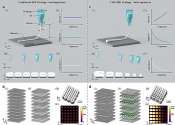Tiny robotic crab is smallest-ever remote-controlled walking robot
Northwestern University engineers have developed the smallest-ever remote-controlled walking robot—and it comes in the form of a tiny, adorable peekytoe crab.
May 25, 2022
0
136
Robotics

Northwestern University engineers have developed the smallest-ever remote-controlled walking robot—and it comes in the form of a tiny, adorable peekytoe crab.
May 25, 2022
0
136
Energy & Green Tech

Texas can be a model for the nation on how to effectively replace coal with wind and solar for the state's energy needs while meeting environmental goals, according to new research by Rice University engineers.
Mar 21, 2022
3
442
Engineering

Material extrusion 3D printing technology is widely utilized in biofabrication/bioprinting, tissue engineering, flexible electronics, and soft robotics. However, the fixed printing parameters and constant filament diameter ...
Jun 28, 2024
0
19
Engineering

University of Florida engineers have developed a method for 3D printing called vapor-induced phase-separation 3D printing, or VIPS-3DP, to create single-material as well as multi-material objects. The discovery has the potential ...
Apr 10, 2024
0
38
Engineering

The challenge before Johns Hopkins University engineering students: Take a leaf blower, but make it quiet. Make it work as powerfully as ever, but do not allow it to emit the ear-piercing caterwaul that has gotten leaf blowers ...
May 14, 2024
1
42
Electronics & Semiconductors

A small international team of material and computer engineers has tested the possibility of using kombucha to make electronic circuit boards. Their paper, posted on the arXiv pre-print server, describes various methods of ...
Energy & Green Tech

Scientists from Nanyang Technological University, Singapore (NTU Singapore) have developed a low-cost device that can harness energy from wind as gentle as a light breeze and store it as electricity.
Oct 6, 2022
0
5737
Engineering

Rice University engineers can turn sunlight into hydrogen with record-breaking efficiency thanks to a device that combines next-generation halide perovskite semiconductors with electrocatalysts in a single, durable, cost-effective ...
Jul 20, 2023
0
3824
Engineering

A breakthrough in electric vehicle battery design has enabled a 10-minute charge time for a typical EV battery. The record-breaking combination of a shorter charge time and more energy acquired for longer travel range was ...
Oct 12, 2022
1
4011
Hi Tech & Innovation

A collaboration between engineers at Lufthansa Technik and chemicals and coatings manufacturer BASF has resulted in the creation of AeroSHARK—a thin film coating that can be applied to an aircraft's outer skin to reduce ...
An engine is a mechanical device that produces some form of output from a given input. An engine whose purpose is to produce kinetic energy output from a fuel source is called a prime mover; alternatively, a motor is a device which produces kinetic energy from other forms of energy (such as electricity, a flow of hydraulic fluid or compressed air). A motor car (automobile) has a starter motor and motors to drive pumps (fuel, power steering, etc) – but the power plant that propels the car is called an engine. The term 'motor' was originally used to distinguish the new internal combustion engine -powered vehicles from earlier vehicles powered by a steam engine (as in steam roller and motor roller).
Military engines included siege engines, large catapults, trebuchets and battering rams.
This text uses material from Wikipedia, licensed under CC BY-SA